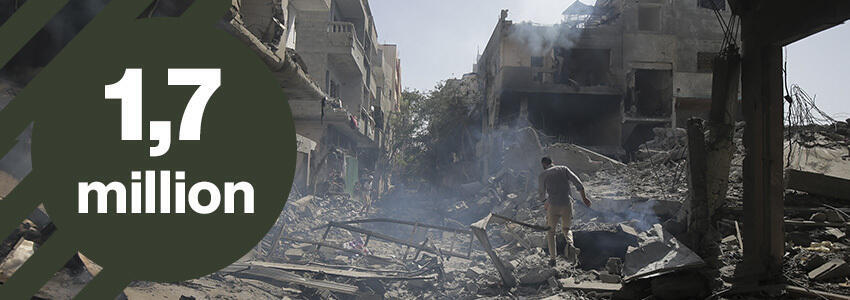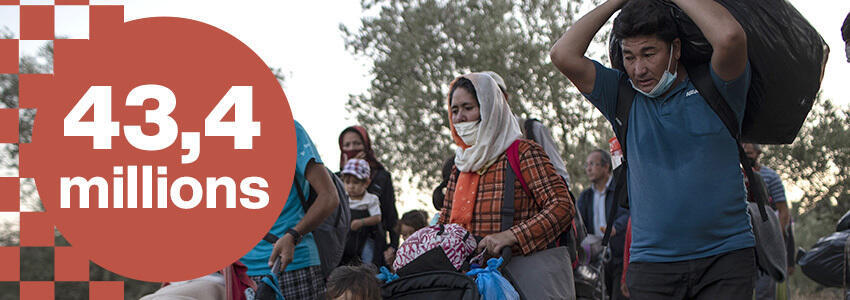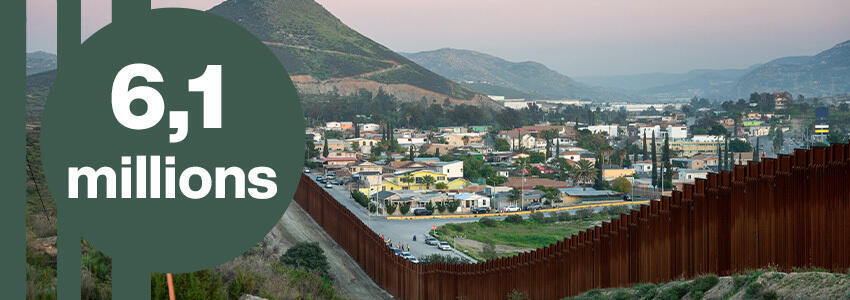For the 12th consecutive year, the number of displaced people has never been so high, underlines the United Nations High Commissioner for Refugees (UNHCR) on Thursday in its annual report. The conflicts in Sudan, Gaza and Burma have aggravated a situation already made very worrying by the war in Ukraine and the humanitarian crisis in Afghanistan.
117.3 million. This is the number of people around the world who have been forced to flee their country or region of origin due to persecution, conflict, violence and human rights violations, according to the United Nations High Commissioner for Refugees. (UNHCR) which publishes, Thursday June 13, a new version of its flagship report on migration. A figure which marks a new record and would even rise, in May 2024, to 120 million, with the conflicts in Sudan, Gaza and Burma creating more new displacements.
“With this figure, the displaced global population would be equivalent to the 12th largest country in the world, roughly the size of Japan,” specifies the UNHCR in its press release.
The UN agency specifies that the largest increase in the number of displacements concerns people fleeing conflicts and who remain in their own country. A phenomenon which concerns 68.3 million people (an increase of almost 50% in five years), reports the UNHCR, citing the Internal Displacement Observatory.
Among the main factors behind the increase in figures is the devastating conflict in Sudan which has led to the displacement of more than 7.1 million people within the country since April 2023, and 1.9 million outside .
DR Congo and Burma are also facing the displacement of millions of people within the country due to violent fighting, as is the Gaza Strip since the Israeli response to the attacks perpetrated by Hamas on October 7.
Read also“In Sudan, there are constant blockages to humanitarian aid from all belligerents”

The number of internally displaced people in the Gaza Strip will reach 1.7 million people by the end of 2023, which represents 75% of the population.
The conflict in the Gaza Strip has had a devastating effect on the Palestinian population, points out the UNHCR. The humanitarian situation there is extremely serious, and the Palestinian enclave’s 2.2 million residents face acute food insecurity and an imminent threat of famine, according to the report.
Read alsoFamine in Gaza: in the North, “people have nothing left to eat”

During 2023, the number of refugees worldwide increased by 7% to 43.4 million.
This figure includes another 5.8 million people in need of international protection, mainly from Venezuela, half a million more people than at the end of the year.
In addition, this figure also includes 6 million Palestinian refugees under the mandate of UNRWA.
“The vast majority of refugees are hosted in neighboring countries,” Shabia Mansoo, UNHCR spokesperson, told France 24. “75% of them reside in low- and middle-income countries that together produce less than 20% of global income.”

Over the whole of 2023, some 5.6 million people requested asylum individually, via collective procedures, or obtained temporary protection, according to the UNHCR, or 17% less than the last year.
“These temporary protection mechanisms can be used as an effective tool in the context of large-scale displacement to provide immediate protection, access to legal status and rights in host countries,” explains Shabia Mansoo. “Collective recognitions or temporary protection help to alleviate pressure on asylum systems resulting from high levels of displacement, thereby avoiding asylum applications that would otherwise be pending,” she continues, citing as an example the case of Syrians in Turkey, Ukrainians in EU countries, or even Somalis in Ethiopia and Yemen.
While the number of new individual asylum applications (3.6 million) and recognitions resulting from collective procedures (891,000) increased compared to 2022, the number of people benefiting from temporary protection (1.1 million) has declined sharply, largely due to fewer people fleeing Ukraine. In 2023, 924,800 Ukrainian refugees received temporary protection mainly in European countries, compared to 3.8 million the previous year.
According to Eurostat datain total, 1,129,800 people applied for asylum in the European Union in 2023. Of these, more than a million did so for the first time. A figure increasing by 20% compared to 2022.
24.3% of the total number of first asylum applications concerned children, including 17% unaccompanied minors.
Syrians, Afghans, Turks, Venezuelans and Colombians were the main nationalities of asylum seekers in the EU in 2023; Germany, Spain, France and Italy were the main destination countries for first-time asylum seekers in the EU in the same year.

Some 6.1 million forcibly displaced people returned to their places of origin in 2023. Among them, more than a million refugees returned to their country of origin (22% less than in 2022), and 5.1 million internally displaced people returned to their region. of origin (i.e. 39% less than in 2022).
“Almost 62% of all returns of internally displaced people took place in DR Congo (1.8 million) and Ukraine (1.3 million),” says Shabia Mansoo. Returns that, for the most part, took place in contexts that were not entirely conducive in terms of security and dignity, and which may not be sustainable.
“Finding solutions for refugees has become extremely difficult,” adds the UNHCR spokesperson. “Large-scale returns have not occurred as in previous decades, when the end of conflicts allowed displaced people and refugees to return home.” Today, she continues, “as existing conflicts prolong and new ones erupt, voluntary returns become more difficult.”

